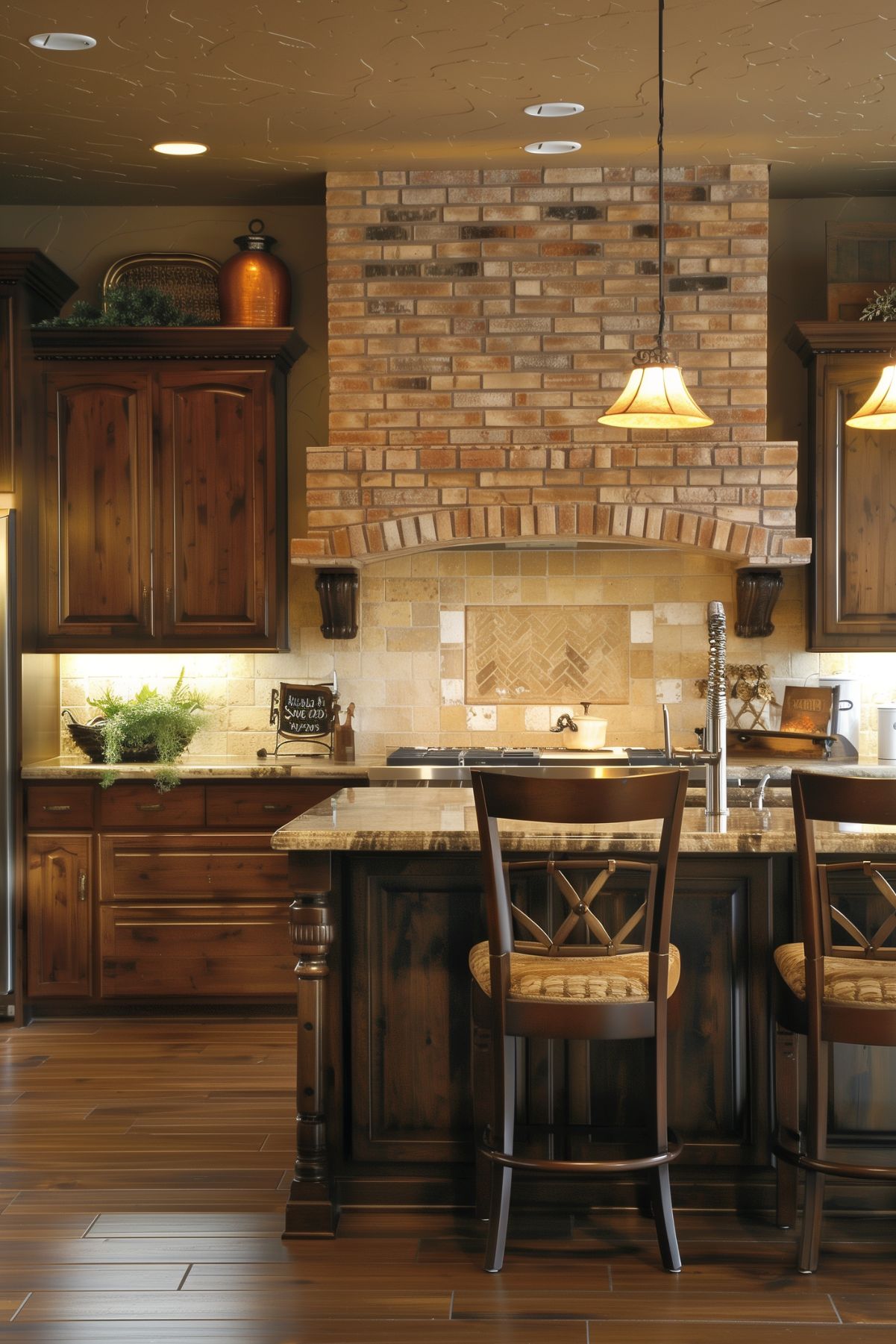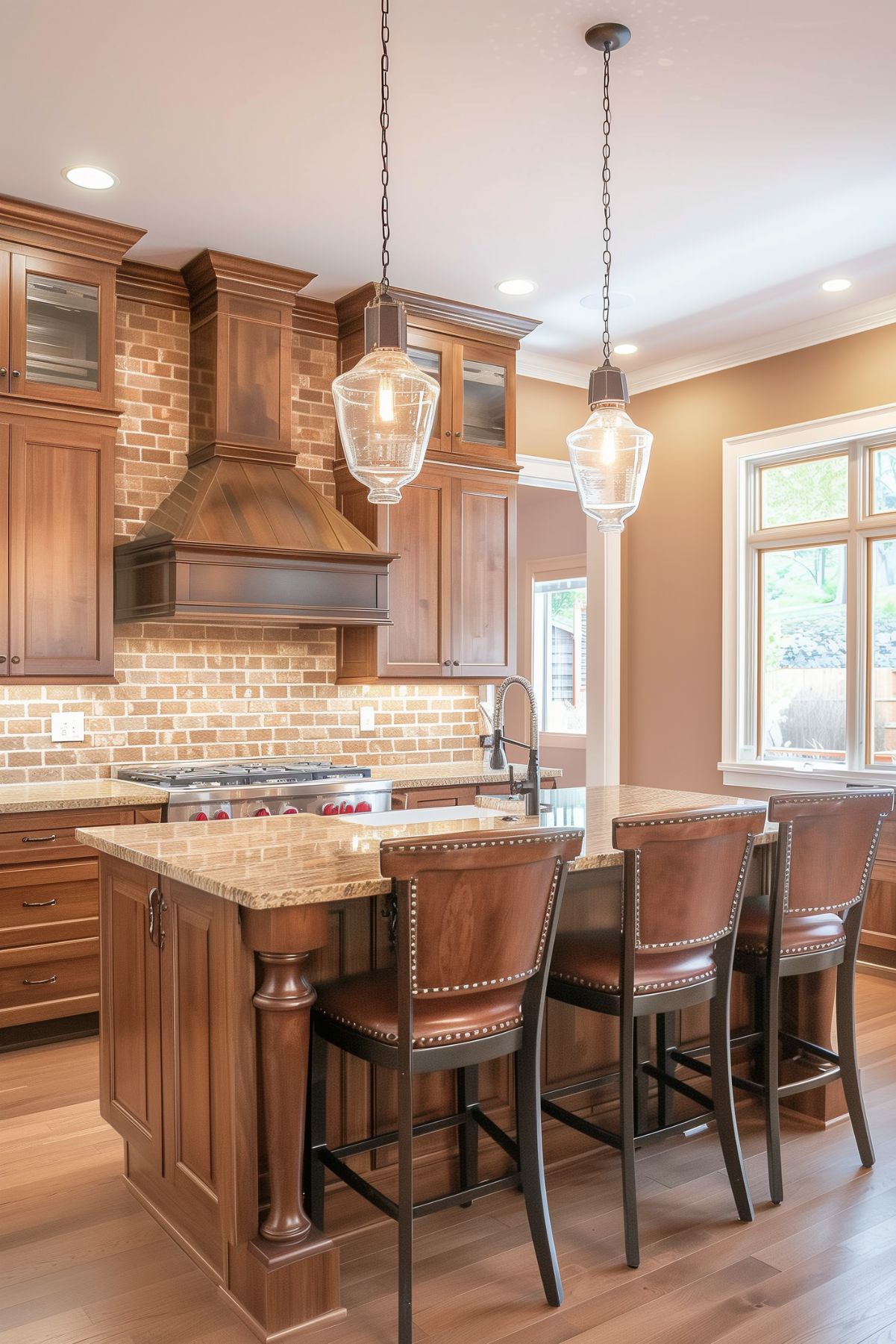The Charm of Brown Kitchens: A Blend of Tradition and Contemporary Style. Brown is a color that has always been associated with warmth, comfort, and stability. It’s a color that has been used in interior design for centuries, and it has always been a popular choice for kitchens.
Brown cabinets, countertops, and flooring have a timeless appeal that makes them a great option for modern kitchens.
In this article, we will explore the enduring appeal of brown in kitchen design and how to integrate it into modern kitchens.

Brown is a versatile color that can be used in a variety of ways in kitchen design. It can be used as a foundation for the entire kitchen, with brown cabinets and countertops providing a warm and inviting space.
It can also be used as an accent color, with brown flooring or backsplash tiles adding depth and texture to the space.
Brown is a color that complements a wide range of other colors, making it a great choice for any kitchen design.
Key Takeaways
- Brown is a timeless color that has been used in interior design for centuries.
- Brown is a versatile color that can be used as a foundation or accent in modern kitchens.
- Brown complements a wide range of colors and can be used in a variety of ways in kitchen design.
The Enduring Appeal of Brown in Kitchen Design

Brown has been a staple color in kitchen design for decades. It is a timeless choice that has stood the test of time and continues to be a popular option for contemporary kitchens.
Brown is a versatile color that can be used in a variety of ways to create a warm and inviting space.
One of the reasons for the enduring appeal of brown in kitchen design is its ability to create a sense of comfort and coziness.
Brown is a warm color that can make a space feel more inviting and welcoming. It can also create a sense of balance and stability, which is important in a room where people spend a lot of time.
Another reason why brown is a popular choice in kitchen design is its versatility. Brown can be used in a variety of ways, from cabinets and countertops to flooring and backsplashes.
It can be paired with a range of other colors, from neutrals like white and gray to bolder hues like red and blue.
Brown is also a practical choice for kitchen design. It is a forgiving color that can hide dirt and stains, which is important in a room where spills and messes are common.
Brown is also a classic color that will never go out of style, making it a smart long-term investment for any kitchen.
The enduring appeal of brown in kitchen design can be attributed to its warmth, versatility, and practicality.
It is a timeless choice that can be used in a variety of ways to create a warm and inviting space that will stand the test of time.
Integrating Brown into Modern Kitchens

Brown is a timeless choice for contemporary kitchens. It is a versatile color that can be used in a variety of ways to create a warm and inviting space.
Here are some tips for integrating brown into modern kitchens.
Choosing the Right Shade
When selecting a shade of brown for your kitchen, it is important to consider the overall style and feel of the space.
Lighter shades of brown, such as beige or taupe, can create a soft and calming atmosphere, while darker shades of brown, such as chocolate or espresso, can add depth and richness to the space.
Combining Brown with Other Colors
Brown can be combined with a variety of other colors to create a modern and stylish kitchen. One popular combination is brown and white, which creates a clean and crisp look.
Another option is to combine brown with black or gray for a more dramatic effect.
For a pop of color, brown can be paired with shades of blue or green.
Selecting Materials and Textures
The materials and textures used in a kitchen can have a big impact on the overall look and feel of the space. When integrating brown into a modern kitchen, it is important to select materials and textures that complement the color.
For example, a brown wood floor can add warmth and texture to the space, while a brown leather bar stool can add a touch of sophistication.
In summary, integrating brown into a modern kitchen can be a great way to create a warm and inviting space.
By choosing the right shade, combining it with other colors, and selecting the right materials and textures, you can create a kitchen that is both stylish and functional.
Brown Cabinets: A Versatile Foundation

Brown cabinets are a timeless choice that can be used to create a contemporary look in any kitchen.
The versatility of brown cabinets allows them to be paired with a variety of design elements, making them a great foundation for any kitchen remodel.
We will discuss the different types of wood and finishes available for brown cabinets, as well as the various cabinet styles and hardware options that can be used to create a unique look.
Types of Wood and Finishes
Brown cabinets can be made from a variety of woods, each with its own unique characteristics.
Some popular options include:
- Cherry: This wood has a rich, warm tone that deepens with age. Cherry cabinets can be stained to a variety of shades, from light to dark.
- Maple: Maple has a light, uniform grain that can be stained to mimic other woods, such as cherry or mahogany. It is a durable wood that resists dents and scratches.
- Oak: Oak has a prominent grain pattern that adds texture and visual interest to cabinets. It can be stained to a variety of shades, from light to dark.
- Walnut: Walnut has a rich, dark tone that can add warmth and depth to a kitchen. It has a straight grain that can be stained to a variety of shades.
In addition to the type of wood used, the finish of the cabinets can also impact their appearance. A glossy finish will reflect light and create a modern look, while a matte finish will create a more traditional, rustic feel.
Cabinet Styles and Hardware
Brown cabinets can be paired with a variety of cabinet styles and hardware options to create a unique look.
Some popular cabinet styles include:
- Shaker: Shaker cabinets have a simple, clean design that can be dressed up or down with the right hardware and accessories.
- Raised Panel: Raised panel cabinets have a more ornate design, with a panel that is raised above the rest of the cabinet door.
- Slab: Slab cabinets have a flat, smooth surface that creates a sleek, modern look.
Hardware options for brown cabinets include:
- Knobs: Knobs are a classic hardware option that can be used to add a touch of elegance or simplicity to cabinets.
- Pulls: Pulls are a more modern hardware option that can be used to create a sleek, contemporary look.
- Handles: Handles are a versatile hardware option that can be used to create a variety of looks, from traditional to modern.
Brown cabinets are a versatile choice that can be used to create a variety of looks in a contemporary kitchen.
By choosing the right wood, finish, cabinet style, and hardware, homeowners can create a unique kitchen that reflects their personal style.
Countertops and Backsplashes: Complementing Brown Cabinetry

Material Selection
When it comes to selecting countertops and backsplashes to complement brown cabinetry, there are a variety of materials to choose from.
Some popular options include:
- Granite: Granite is a durable and stylish choice that comes in a wide range of colors and patterns. It pairs well with brown cabinetry, particularly if the granite has flecks of brown or gold in it.
- Quartz: Quartz is a low-maintenance option that is resistant to scratches and stains. It is available in a range of colors, including shades of brown and beige.
- Marble: Marble is a luxurious option that adds elegance to any kitchen. It is available in a variety of shades, including brown and beige.
- Butcher Block: Butcher block countertops are a warm and inviting option that add a rustic touch to a kitchen. They pair well with brown cabinetry, particularly if the cabinetry has a natural wood finish.
Color Coordination
When selecting a countertop or backsplash to complement brown cabinetry, it is important to consider color coordination.
Some tips to keep in mind include:
- Contrast: Choosing a countertop or backsplash that contrasts with the brown cabinetry can create a striking look. For example, a white or light-colored countertop can provide a nice contrast to dark brown cabinetry.
- Complement: Selecting a countertop or backsplash that complements the brown cabinetry can create a cohesive look. For example, a beige or tan countertop can enhance the warm tones of brown cabinetry.
- Accents: Adding accents in a contrasting or complementary color can also enhance the look of brown cabinetry. For example, adding a blue or green backsplash can provide a pop of color that complements brown cabinetry.
Selecting the right countertops and backsplashes can enhance the look of brown cabinetry in a contemporary kitchen.
By considering material selection and color coordination, homeowners can create a stylish and timeless space that they will enjoy for years to come.
Flooring Options to Match Brown Kitchens

When it comes to designing a contemporary kitchen with a brown color scheme, choosing the right flooring can make all the difference.
The right flooring can enhance the warmth and richness of the brown tones while also providing durability and functionality.
Here are two popular flooring options that can complement brown kitchens:
Hardwood and Laminate Choices
Hardwood and laminate flooring are popular choices for kitchens because they are durable and easy to maintain.
They also come in a variety of brown shades, making it easy to find a color that matches the kitchen’s color scheme.
Some popular hardwood choices include oak, maple, and hickory, while laminate options can mimic the look of hardwood at a more affordable price.
One advantage of hardwood and laminate flooring is that they can be refinished if they become scratched or worn over time.
This makes them a great long-term investment for homeowners who want a flooring option that will last for years.
Tile and Stone Alternatives
Tile and stone flooring can also be a great choice for brown kitchens. They are durable and easy to clean, making them a practical choice for busy kitchens.
Additionally, they come in a variety of colors and patterns, making it easy to find a style that matches the kitchen’s design.
One popular tile choice for brown kitchens is porcelain tile, which is known for its durability and water resistance.
Another option is natural stone, such as slate or travertine, which can provide a unique look that adds texture and depth to the kitchen.
When choosing tile or stone flooring, it’s important to consider the size and shape of the tiles.
Larger tiles can make a small kitchen look larger, while smaller tiles can provide a more intricate design.
It’s also important to choose a grout color that complements the brown tones in the kitchen.
Overall, both hardwood/laminate and tile/stone flooring options can be a great choice for a brown kitchen.
Homeowners should consider the durability, maintenance, and design options of each type of flooring before making a final decision.
Lighting Considerations for Brown Kitchens

When it comes to designing a brown kitchen, lighting is a crucial element to consider.
Proper lighting can enhance the warmth and cosiness of the space, while also making it more functional and practical.
Natural Light Utilization
Natural light can bring out the richness and depth of brown hues in a kitchen. Therefore, it is essential to maximize natural light utilization in the design process.
Consider the following tips:
- Window Placement: When designing a brown kitchen, it is crucial to place windows strategically to allow for maximum natural light. Large windows or skylights can bring in plenty of natural light and make the space feel more open and airy.
- Window Treatments: Window treatments can also play a role in natural light utilization. Sheer or translucent curtains can allow for maximum natural light while still providing privacy and light control.
- Reflective Surfaces: Incorporating reflective surfaces such as mirrors or glossy tiles can help bounce natural light around the kitchen, making it feel brighter and more spacious.
Artificial Lighting Fixtures
While natural light is ideal, artificial lighting fixtures are necessary for when natural light is not enough.
Consider the following tips when selecting artificial lighting fixtures for a brown kitchen:
- Warm Bulbs: Warm bulbs can complement brown cabinetry and bring out the warmth of the space. Consider using LED bulbs with a color temperature of 2700K to 3000K for a warm and inviting glow.
- Layered Lighting: Layered lighting can help create a warm and inviting atmosphere in a brown kitchen. Consider using a combination of overhead fixtures, under-cabinet lighting, and accent lighting to create a layered effect.
- Bronze Finish: Fixtures with a bronze finish can complement brown cabinetry and add a touch of elegance to the space. Consider using bronze-finished pendant lights or chandeliers to enhance the warmth and cosiness of the kitchen.
Lighting is a crucial element to consider when designing a brown kitchen.
By maximizing natural light utilization and selecting the right artificial lighting fixtures, you can create a warm, inviting, and practical space that is perfect for contemporary kitchens.
Accessorizing Your Brown Kitchen

When it comes to accessorizing a brown kitchen, there are a few key areas to focus on. By incorporating metal accents, textiles, and decorations, you can elevate your kitchen’s style and create a cohesive look.
Metal Accents and Fixtures
Metal accents and fixtures are a great way to add a touch of shine and sophistication to your brown kitchen.
Consider incorporating brushed nickel or stainless steel hardware for your cabinets and drawers.
These finishes complement brown cabinets beautifully and add a modern touch to your kitchen.
In addition to hardware, you can also add metal accents through lighting fixtures, such as pendant lights or chandeliers.
These fixtures can serve as a statement piece in your kitchen and tie the entire room together.
Textiles and Decorations
Another way to accessorize your brown kitchen is through textiles and decorations. Consider adding a patterned rug or runner to your kitchen floor.
This can add visual interest and texture to the space while also protecting your floors.
You can also incorporate textiles through curtains or window treatments. Choose a fabric that complements your brown cabinets, such as a neutral or patterned option.
Finally, don’t forget to add decorations to your kitchen. Consider displaying a collection of vintage dishes or adding artwork to your walls.
These small touches can add personality and warmth to your brown kitchen.
Accessorizing your brown kitchen is all about finding the right balance of finishes, textures, and decorations.
By incorporating these elements, you can create a beautiful and timeless space that you’ll love for years to come.
The Psychological Impact of Brown in Kitchen Spaces

Brown is a warm and earthy color that is often associated with stability, reliability, and comfort. In kitchen spaces, brown can create a cozy and inviting atmosphere that makes people feel at home.
Brown is also a versatile color that can be paired with a variety of other colors to create different moods and styles.
According to color psychology, brown is a grounding color that can help people feel more connected to the earth and to their own bodies.
Brown can also evoke feelings of security, stability, and dependability. In kitchen spaces, these psychological associations can help people feel more relaxed and at ease while cooking or entertaining guests.
One way to incorporate brown into a kitchen space is through the use of natural wood elements. Wooden cabinets, countertops, and flooring can add warmth and texture to a kitchen while also providing a sense of durability and longevity.
Another way to use brown in the kitchen is through the use of brown-toned paint or wallpaper.
This can create a cozy and intimate atmosphere that is perfect for family gatherings or casual dinners.
When using brown in the kitchen, it’s important to balance it with other colors to prevent the space from feeling too dark or heavy.
Lighter colors such as white, beige, or pale blue can help to brighten up the space and create a sense of balance.
Incorporating natural light sources such as windows or skylights can help to bring out the warmth and richness of brown tones.
Brown is a timeless choice for contemporary kitchens that can create a sense of comfort, stability, and connection to the earth.
By using natural wood elements, brown-toned paint or wallpaper, and balancing it with lighter colors and natural light sources, brown can create a warm and inviting atmosphere that is perfect for cooking, entertaining, and spending time with loved ones.











